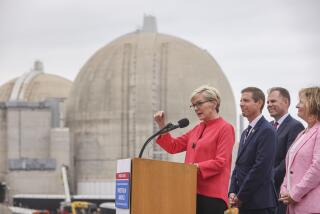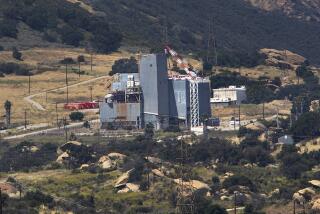3 Nuclear Monitoring Sites in U.S. Proposed for Soviets
- Share via
LA JOLLA — Under the largest private U.S.-Soviet scientific effort ever launched, American scientists have suggested two sites in Nevada and one in California at which to place seismic stations for the Soviets to monitor U.S. underground nuclear testing in Nevada, it was announced Monday at the Scripps Institution of Oceanography of UC San Diego.
The announcement was made as five Soviet seismological experts began two days of talks Monday at the University of California, San Diego, on the precise locations for the stations, which would be similar to three in place and manned by scientists from UCSD and University of Nevada at Reno since July around the major Soviet nuclear test site 1,800 miles southeast of Moscow.
The three preferred sites were identified as Deep Springs, Calif., east of Bishop in the White Mountains; Nelson, Nev., south of Las Vegas below Hoover Dam, and Railroad Valley, Nev., in the Grant Mountain range southwest of Ely. The sites are arranged around the Nevada test facility in a large triangular pattern.
The Soviets’ arrival here Sunday is a part of the second phase of an unusual, privately arranged bilateral effort to show that underground nuclear tests can be accurately monitored and that fears of violations going undetected under a comprehensive test-ban treaty should not be an impediment to concluding a government-to-government agreement.
The Soviet delegation is under the sponsorship of the Natural Resources Defense Council, a New-York based environmental group that opposes nuclear testing. The Soviet scientists are associated with the Soviet Academy of Sciences, a Soviet government body that signed the joint monitoring agreement with the resources council.
The U.S. government has no connection with the project and it has officially expressed skepticism about the agreement. While the joint monitoring is narrowly designed to show that technical considerations should not be a bar to a test ban, officials of the resources council readily admit that their political agenda is to pressure the Reagan Administration toward new negotiations on a ban. President Reagan opposes a test ban, questioning verification procedures and arguing that continued testing is necessary to assure the potency of the American nuclear arsenal.
Earlier, in response to a Soviet call for a comprehensive test-ban treaty, the Reagan Administration had proposed that Soviet scientists be present in Nevada during a U.S. nuclear explosion. But the Soviet scientists declined.
“We are seismologists, not nuclear specialists,” Igor L. Nersesov, chief of the seismological branch of the Institute of Physics of the Earth in Moscow, said at a press conference here. “We don’t need to see any kind of testing of a nuclear explosion.” Scientists from UCSD and the University of Nevada were allowed unhindered access to the Soviet testing site of Semipalatinsk prior to setting up their equipment.
UCSD scientists reconnoitered numerous sites around the Nevada test site and are presenting details on each location to the Soviet delegation for their revision and expected approval. The resources council selected UCSD seismologists to carry out the bulk of the technical effort both in the Soviet Union and in Nevada.
Selection Based on Geology
James Brune, UCSD professor of geophysics, said that selection is based on geology as well because scientists want to minimize so-called background noise in attempting to pick up the distinctive seismic waves generated by nuclear tests.
If the Soviets accept the sites and leasing is approved, equipment could be operating by March of next year, Thomas Cochran, senior staff scientist for the resources council, said Monday. Should Soviet scientists not be permitted to jointly operate the sites, American technicians will take all necessary measurements and make the data available to the Soviets, Jacob Scherr, another resources council official, said. “Such an obstacle is a petty one and it will not stand in our way,” Scherr said.
Because of the ongoing Soviet moratorium, the American sites in the Soviet Union have not recorded any nuclear tests but have accumulated a substantial amount of data based on measurements of earthquakes and chemical and other explosions.
More to Read
Sign up for Essential California
The most important California stories and recommendations in your inbox every morning.
You may occasionally receive promotional content from the Los Angeles Times.










